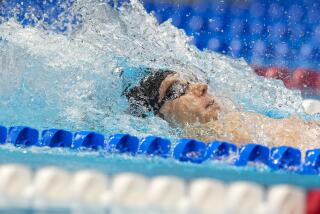High-tech swimsuits may have given swimmers advantage, study says
- Share via
Remember those full-body high-tech swimsuits worn at the 2009 World Swimming Championships in Rome--the event that saw an unprecedented 43 world records set? A study examining the event finds that the suits may have offered a distinct advantage.
This isn’t the first time the polyurethane suits have been implicated in allowing swimmers to break so many records; after it was alleged that the suits decreased drag through the water, compressed the muscles and increased buoyancy, they were banned from competition.
Researchers from the Feinberg School of Medicine at Northwestern University in Chicago wanted to determine if it truly was the suits that gave swimmers an advantage, and not other factors such as better training or superstar talent. They compared swim race data from 2009 with track data from the same year, since the two share some similarities: they both have individual and group races, incorporate sprint and endurance events and don’t use equipment.
By process of elimination several factors were ruled out, including training science (there were no across-the-board major improvements), more people entering the sport (numbers increased steadily without spiking from 1990 to 2010) and ultra-talented athletes entering the competition. With the the exception of Michael Phelps, who broke three of the 15 men’s world records at the 2009 event, no other single person won a lion’s share of medals.
That pretty much left the swimsuits. The study authors wrote that all the swimmers who broke records at the championships wore the high-tech suits. Since the suits were banned in 2010 there’s been a trend toward slower times.
“The data indicate that it was more than just hard work that allowed these athletes to break an unprecedented number of world records in a record period of time,” the authors wrote. “The equipment played a significant role, too.”
The study was published in the December issue of the Journal of Strength and Conditioning Research.
More to Read
Go beyond the scoreboard
Get the latest on L.A.'s teams in the daily Sports Report newsletter.
You may occasionally receive promotional content from the Los Angeles Times.







